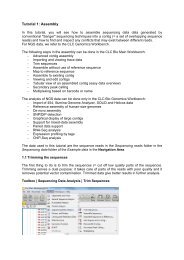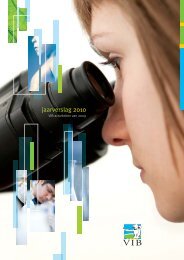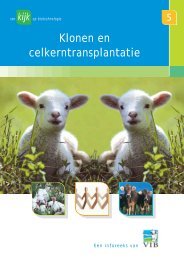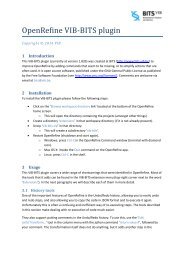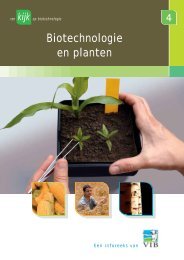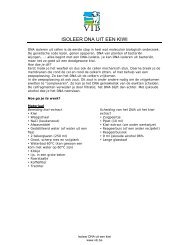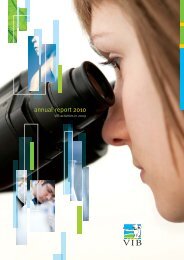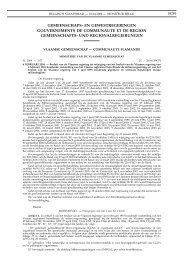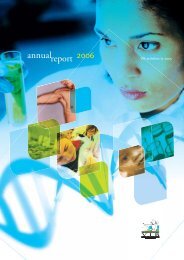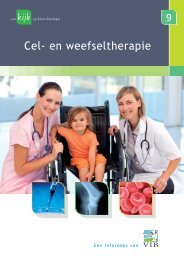Biosafety in the laboratory - VIB
Biosafety in the laboratory - VIB
Biosafety in the laboratory - VIB
Create successful ePaper yourself
Turn your PDF publications into a flip-book with our unique Google optimized e-Paper software.
3. CLASSIFICATION AND<br />
RISK ASSESSMENT<br />
Pathogenic organisms<br />
Organisms are divided <strong>in</strong>to four categories of risk. Organisms that are not able to cause<br />
disease belong to risk group 1. Pathogenic organisms belong to <strong>the</strong> risk groups 2, 3 or 4,<br />
depend<strong>in</strong>g on <strong>the</strong>ir degree of pathogenicity and <strong>the</strong> availability of effective treatment. To<br />
dist<strong>in</strong>guish between <strong>the</strong> classification of natural non-modified pathogens and GMOs, <strong>the</strong><br />
pathogen classification uses <strong>the</strong> term risk groups or sometimes also biological risk class,<br />
while for <strong>the</strong> GMO classification <strong>the</strong> term risk class is used. Below an overview is given of<br />
<strong>the</strong> def<strong>in</strong>itions of <strong>the</strong> different risk groups.<br />
Group 1<br />
Group 2<br />
Group 3<br />
Very unlikely to cause disease <strong>in</strong> humans, animals or plants.<br />
Human pathogens (micro-)organisms that can cause disease <strong>in</strong> humans and pose a hazard<br />
to persons that are directly exposed to it. Their spread to <strong>the</strong> community<br />
is unlikely. Profylaxis or effective treatment is mostly available.<br />
Animal pathogens (micro-)organisms that can cause disease <strong>in</strong> animals and that possess<br />
<strong>in</strong> different extend one of <strong>the</strong> follow<strong>in</strong>g properties: limited geographical<br />
importance, transmission to o<strong>the</strong>r limited or non-existent species,<br />
absence of vectors or carriers. Limited economic and/or medical<br />
impact. Profylaxis and/or effective treatment is mostly available.<br />
Fytopathogens (micro-)organisms that can cause disease <strong>in</strong> plants, but for which <strong>the</strong>re<br />
is no higher risk of an epidemic when <strong>the</strong>y are accidentally dissem<strong>in</strong>ated<br />
<strong>in</strong>to <strong>the</strong> Belgian environment. Profylaxis or effective treatment is<br />
available. Non-<strong>in</strong>dig<strong>in</strong>ous or exotic fytopathogens that are not able to<br />
survive <strong>in</strong> Belgium because of <strong>the</strong> absence of target plants or because<br />
of unfavourable wea<strong>the</strong>r conditions, belong to this risk group.<br />
Human pathogens (micro-)organisms that can cause serious disease <strong>in</strong> humans and pose a<br />
hazard to persons that are directly exposed to it. There is a risk of spread<br />
to <strong>the</strong> community. Profylaxis or effective treatment is mostly available.<br />
Animal pathogens (micro-)organisms that can cause serious disease or epizotic <strong>in</strong> animals.<br />
Spread to o<strong>the</strong>r species is more than possible. Some of <strong>the</strong>se<br />
pathogenic agents require specific sanitary measures. Profylaxis or<br />
effective treatment is mostly available.<br />
Fytopathogens (micro-)organisms that can cause a disease <strong>in</strong> plants with important<br />
economic or environmental consequences and for which treatments<br />
are non-existent, difficult to apply or costly. Accidental spread may<br />
lead to local epidemics. Exotic stra<strong>in</strong>s of fytopathogens usually occur<strong>in</strong>g<br />
<strong>in</strong> <strong>the</strong> Belgian environment and not <strong>in</strong> <strong>the</strong> list of <strong>the</strong> quarant<strong>in</strong>e<br />
organisms also belong to this risk group.<br />
Classification and risk assessment 9



